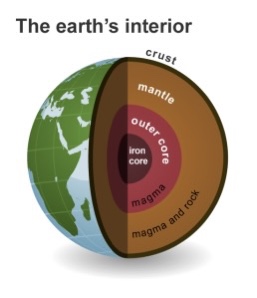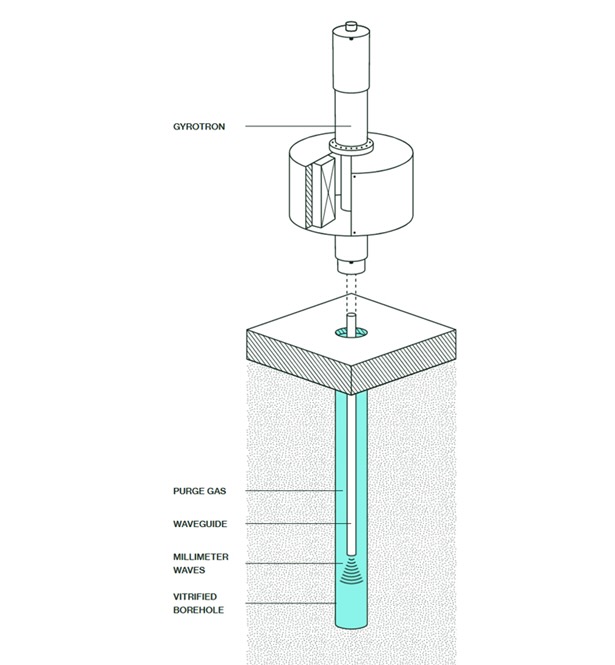Since prehistoric times, humans have used heat from deep within the core of the earth for a wide variety of purposes. Now, this ancient energy source, denominated geothermal power, is being lauded as an environmental way to provide large amounts of electricity and heat for the population of the world.
Geothermal energy is renewable and continuously produced at the center of the planet. This venerable heat source is undergoing a modern renaissance, as startups and more established power companies are moving to incorporate geothermal into future plans.
All the main geothermal energy stations in use today utilize steam and hot water pumped from underground geothermic reservoirs to produce electricity. Wells are typically drilled at between 150 to 400 feet deep to access the energy.
Currently, the most common geothermal energy production system is called a flash steam power plant. This type of power plant routes hydrothermal fluid from a well at temperatures over 182°C (360°F) under high pressure into a tank at the surface.
The tank’s much lower pressure causes some of the fluid to quickly dissipate as vapor, which is then used to drive a turbine. Dry steam power stations and binary cycle plants are the two other types of geothermal plants.

Geothermal energy plants have a low carbon footprint. Unlike fossil fuel and nuclear facilities, they don’t wreck the environment around them. Geothermic power is considered one of the cleanest forms of renewable energy available today.
As we’ll see, startups have ambitions to drill much deeper than ever before to unleash the power of geothermal globally.
HISTORY
One natural occurrence of geothermal energy happens when magma beneath the earth’s surface heats groundwater that has drained through porous rock. Back at the surface, this can manifest either as a hot spring or — more rarely — a geyser, depending on the conditions underground.
Human use of geothermal energy has a very long history. Prehistoric peoples were attracted to hot springs, using the natural hot water bubbling up at the sites for cooking, medicinal cures, and even spiritual purposes.
The first industrial uses of geothermal started early in the 19th century. By the middle of the 20th century, multiple geothermal power plants and heating systems existed across the world. The oil crisis of the 1970s and more recent climate change protocols of the 1990s brought geothermal to the fore as a renewable energy source.
In 2019, geothermal facilities in the U.S. “generated baseload power accounting for 0.4 percent of all US utility–scale generation,” according to Vincent Gonzales. Global geothermal power generation capacity stood at 15,854 Megawatts (MW) at the end of 2021.
HOT ROCK COUNTRIES
There are five countries that generated more than a gigawatt (GW) of geothermal energy in 2021, according to Think GeoEnergy Research. These nations include the U.S., Indonesia, the Philippines, Turkey, and New Zealand.
For many countries, there is a lot of room to grow their geothermal capacity in the coming years. There are about 600 geothermal plants in operation around the world or being built, with another 600 being planned, the BBC quotes Alex Richter, former president of the International Geothermal Association. “All major utilities in Europe are looking at geothermal in one way or another,” Richter said.
The U.S. Department of Energy (DOE), meanwhile, says that the earth’s energy can be tapped almost anywhere with geothermal heat pumps and direct–use applications. Other enormous and worldwide geothermal resources — hot dry rock and magma, for example — are awaiting further technological development.
The DOE notes that “hydrothermal resources — reservoirs of steam or hot water — are available primarily in the western states, Alaska, and Hawaii.” The largest geothermal complex in the world is made up of 22 power stations and is located north of San Francisco.
STARTUPS
There are a number of startups receiving funding for geothermal ventures. Most interesting among these is Quaise Energy, a young company with MIT roots that has developed a drilling platform that uses high–frequency millimeter waves to bore deep into the earth. Quaise’s technology uses a vacuum electronic device called a gyrotron to develop terahertz millimeter waves for ultra–deep drilling.
 Quaise Energy’s gyrotron device (Source: Quaise Energy) (Click image to enlarge)
Quaise Energy’s gyrotron device (Source: Quaise Energy) (Click image to enlarge)
Quaise says that to grow geothermal to terawatt levels, we must drill deeper, faster, and hotter than was ever possible before. The company will use conventional rotary drilling to access basement rock and then switch to its new technology to drill down to 20 km where temperatures reach 500°C (932°F).
“Our technology allows us to access energy anywhere in the world, at a scale far greater than wind and solar, enabling future generations to thrive in a world powered with abundant clean energy,” said Carlos Araque, CEO and co–founder of Quaise. The startup believes that deep geothermal energy can be accessed by its novel drilling technology.
Quaise hopes that its millimeter wave–powered drilling will enable power companies to reach massive amounts of carbon–free energy resources in the coming years. Quaise says it will build drilling machines to demonstrate its technology in the field by 2024. The startup has raised $63 million in funding so far.
IOT APPLICATIONS
Internet of things (IoT) and Artificial Intelligence (AI) are starting to be used in geothermal power plants to increase energy station capacities. Although the hot rocks offer a constant and steady output of renewable energy, the costs for generating solar power have dropped precipitously over recent years. So, geothermal plants will need to develop ways to increase energy capacity while reducing costs to compete.
In 2018, Toshiba said that it was testing predictive diagnostics to catch problems with the power stations ahead of time. One particular problem for geothermal plants is solid components (scales) formed from silica and corrosive gasses that can crystallize in turbines, heat exchangers, and pipes, thereby reducing their performance. AI and IoT is used to optimize the use of chemical sprays that reduce the buildup of scales, Toshiba said.
The Great Rift Valley in East Africa offers enormous — and largely untapped — possibilities for generating geothermal energy. The United Nations Industrial Development Organization (UNIDO) estimates that the region could potentially produce 15 GW of power, serving 700,000 homes in the area.
UNIDO, working with the Japanese government, plans to install sensors in power generators and turbines in the African valley to detect ground temperature and vibrations.
“The data extracted from the process will be analyzed by computers in order to increase the plants’ efficiency,” UNIDO said. “The technology allows companies to remotely monitor and manage the production and distribution of energy in real–time.”

